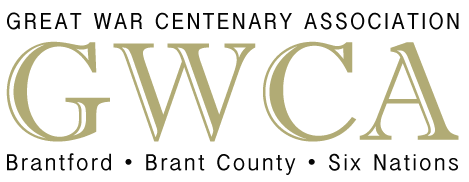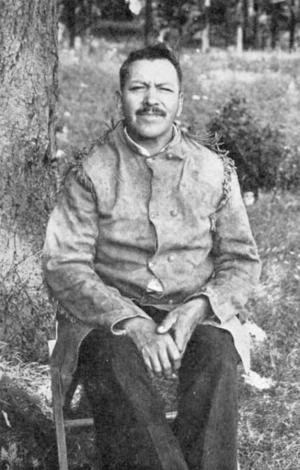BX December 15, 1943
Missing Indian’s Boat Found in the River on Tuesday – Simeon Gibson, Missing Since Friday, Has Not Been Located
The boat belonging to Simeon Gibson, 54, Six Nations Reserve, who has been missing from his home since Friday, has been found, Royal Canadian Police announced today.
Four Indian lads, who were searching the river-banks near Middleport, found it in the water, caught on some weeds yesterday afternoon. The boys had been searching for some time, and found the boat about one-quarter of a mile from the place where Mr. Gibson usually boarded it to go across the river from Middleport to his home.
A farmer who lives not far from the river, noticed Mr. Gibson going past his home at approximately 6 o’clock Friday evening apparently going down to get into his boat. A while later, his wife heard a man cry out, and remarked on it to her husband. Believing that it was from boys playing near the railroad, they forgot about the matter.
Police stated that if the man had drowned it would be a very difficult job to locate his body since ice on the surface of the water prevents any attempts to drag.
BX December 28, 1943
Noted Ethnologist Paid a Fine Tribute to Simeon Gibson – William Fenton Praises Work of Local Indian Believed Drowned
William N. Fenton, Senior Ethnologist at the Smithsonian Ethnology, Washington, has forwarded the information that Simeon Gibson, Iroquois Informant, 1189-1943, who was recently reported missing from his home, and who may possibly have been drowned in the Grand River, on the night of December 10, when he was crossing the river in a small boat, has “left his mark in the annals of Canadian and American science,” in his work among the Six Nations, and for the institute.
“Mr. Gibson,” said Mr. Fenton, “served J.N.B. Hewitt, an ethnologist with the Smithsonian Institution, and well-known in Brantford, for almost 50 years. During that period, Mr. Gibson knew almost every anthropologist, both Canadian and American, who studied among the Six Nations, for the house of Chief John Gibson, his father. He became a Messa for linguists and ethnologists. It is with a sense of keen personal loss that I read the news of him.”
High Tribute
Mr. Fenton went on to pay high tribute to this warrior of the Cayuga tribe and life-long member of the Onondaga Longhouse on the Six Nations Reserve.
“In Simeon Gibson’s passing, the Six Nations has lost a genial member and American Ethnology an unusual character,” he said. “For a half century almost every ethnologist who had gone to the Six Nations knew Simeon Gibson in some capacity.”
He was born August 1, 1887, the son of the Seneca Chief John A. Gibson, who was unquestionably the greatest mid of his generation among the Six Nations. From his eighth year, Simeon remembered guiding his blind father over the river to dictate the Daganawi dah legend to J.N.B. Hewitt, and he translated texts for Hewitt during his last field trip to the Grand River in 1936. Simeon recalled with pleasure traveling from house to house on the Reserve in 1907 with Mr. Harrington collecting for museums in New York City.
Few old Delaware or Iroquois specimens escaped them. He remembered Frachtenberg, who came from Tutelo and learned Mohawk in a few weeks, and Edward Sapir, from Ottawa, who retained the Gibson family – Chief John and his sons Hardy and Simeon – as collecting agents for the Victoria Memorial Museum, and as impresarios for F.W. Waugh, A.A. Goldenweiser, and Sir Francis Knowles.
He could read phonetic transcription and actualize notes into several dialects. Such virtuosity became credible when one considers his rearing.
His mother, Mary Skye, was a Cayuga matron and guardian of her brother’s title, Chief Abram Charles, Hewitt’s second informant. With maternal descent, Simeon was therefore a Cayuga, although “Onondaga on the list.” Chief John, his father, was head chief of the Seneca tribe and knew that dialect from is mother who was full Seneca, but his father was Onondaga and that was the language of their Longhouse and neighborhood.
Veteran of War
When he went to day school, he learned Mohawk and Tuscarora from the children, and some English.
In World War I he enlisted in the Indian Battalion of the Dufferin Rifles and served overseas as a machine gunner during 16 months, largely in first lines at Passchendaele, Vimy Ridge, Arras, and he was gassed during the last great offensive. Yet he seldom spoke of the war or of his role in it, but he loved to describe Oxford, Cambridge, Aldershot and the British Museum – places that he visited on furlough.
“Simeon Gibson leaves no list of publications. His pride was in knowing the archaic language of the Iroquois League, and I believe that he derived deep satisfaction in interpreting for me the texts of laws and rituals that his father and uncle had given to Hewitt and Goldenweiser. In 1939 he reviewed Waugh’s notes on medicines and related activities and took paradigms in several dialects. The next year he demonstrated his grasp of native religion by outlining and detailing the entire ceremonial cycle of Onondaga longhouse, including many of the prayers and announcements. The gas attack that left him a victim of asthma, spoiling his voice for singing and speaking, had not impaired his memory. He urged me to get on with the translating of texts: “there are only myself and my brother who can explain the meanings of the old words. You can read them, but when we are gone the meanings will be lost.”
Made Recordings
“In the winter of 1941 we made recordings of a large number of songs from the Iroquois longhouse and the rites of the Medicine Societies. It was Simeon’s ambition to arrange for me a complete documentary film with recordings of the fast failing Condolence Ceremony for making League Chiefs, but conditions have postponed the project, and it may never be possible of fulfillment since the Life Chiefs of the old Council that went underground in 1924 are rapidly falling by the trail.
“Plans were made to bring Simeon Gibson to Washington in 1941 for the purpose of translating the Deganawidah Legend, but his barn blew down and he could not leave home. There were two versions of this Legend of the founding of the Iroquois Confederacy – both in Onondaga by Chief Gibson.
“Whatever may be remarked of Simeon Gibson’s ambition, industry, or intelligence among his farming neighbors, it can be said that he seemingly derived as much satisfaction from completing such intellectual pursuits as an ethnologist.
“Mr. Gibson is survived by an elder sister, Jemina Gibson, a brother, Chief John Hardy Gibson and several grown daughters by his late first wife, his present wife, and three small children. His keen wit and sober nature will be missed by all his neighbors, both the Indians and the white people over the river whom he helped at harvesting; and the Six Nations Reserve will not seem the same again without Simeon.
“Weather prognostication was one of his principal pastimes, and it amused him greatly when he looked at the heavens, felt the wind, and his sign failed to come true. Perhaps it is the irony of fate that with many others he forecast an open winter this year because there were so few hickory nuts.”
Search Continuing
Search for the body of Mr. Gibson is continuing. It was learned at the Indian Office here today that the ice on the Grand River at Middleport will be blasted this afternoon in an effort to bring the body to the surface.

